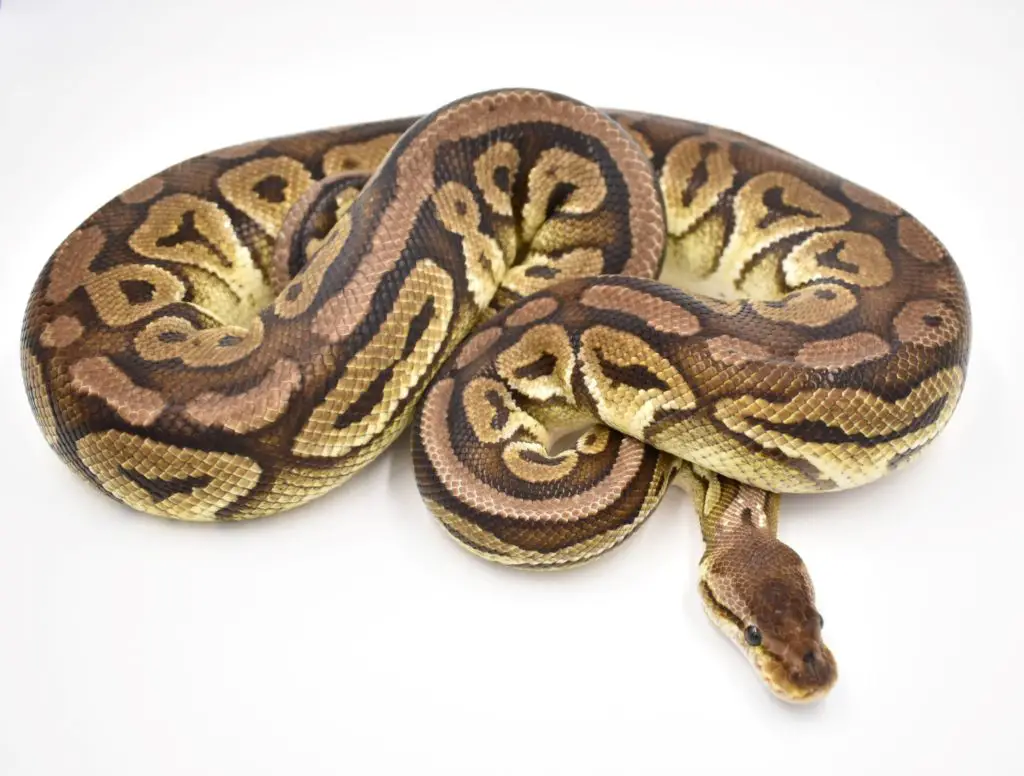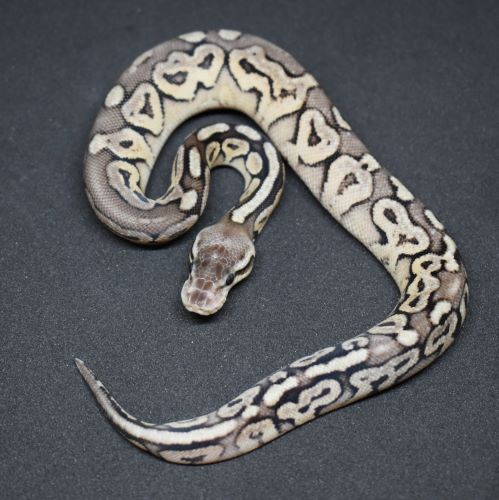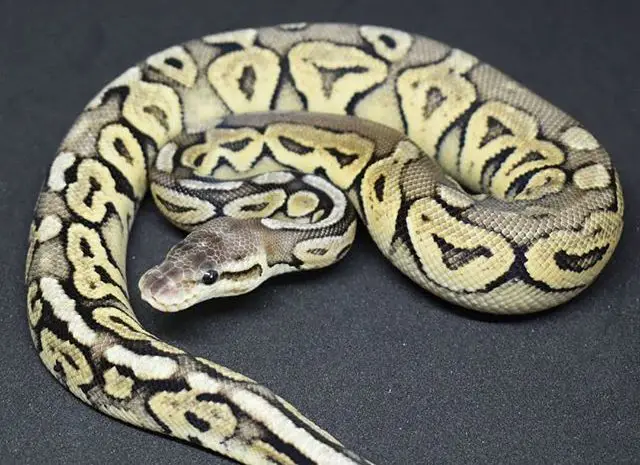First produced by Graziani Reptiles Inc. in 2003, the Pewter Ball Python is just as beautiful as the precious metal it’s named after. Though originally a popular standalone morph, it now has a place in many other projects. Let’s find out why…
Pewter Ball Python Genetics and Morph type
Pewter Ball Pythons are produced from crossing two incomplete dominant genes: Cinnamon and Pastel. By incomplete dominant, I mean genes that are commonly referred to as “co-dom.”
If just one parent possesses an incomplete dominant gene, they can pass it to roughly 50% of the offspring which will in turn visually express them.
That said, when both parents possess one of these genes, the offspring can have two copies of them, making them “supers.”
Description

Though it’s hard to see from the photo above of Prince, my male Pewter, adults of this morph eventually take on a silvery/grey sheen. This is reminiscent of Pewter, a metal made of tin, copper, and silver which is often used for jewellery.
Quite a flattering thing to be named after if you ask me!
Notwithstanding, this silvery sheen isn’t the only colour they have. On their dorsum and flanks Pewters tend to have an almost grey to white pattern as hatchlings. Over time, subtle shades of brown enter this patterning and reduce the contrast.
In both hatchlings and adults, the background colour is black and brown. On the flanks, white and occasionally yellow blushing can be seen. If no other genes are present, the belly is always solid white.
In summary:
- dorsum (back) – very dark brown with tan blotches. General silvery sheen
- flanks – light tan, with blushing between the blotches (also known as “alien heads”)
- head – dark brown on top with only slight blushing, tan stripes through each eye
- eyes – black but may have brown or yellow pigment in top half or iris
- lips – white
- belly – all white
Does the Pewter Ball Python have genetic issues?
Pewter Ball Pythons do not have any genetic issues. In my experience they are identical to other Ball Pythons in terms of fertility, feeding response and overall health.
What is important to know however, is that the Cinnamon gene can have genetic issues in its super form. This is a consideration when using a Pewter for breeding.

Breeding tips
This morph is interesting because of it’s dark and silvery tone. So, when you use it in a breeding project you need to be aware elements of this unique appearance will shine through.
If you like the grey and black tones in a Pewter, you may want to consider breeding it to another one. In this case you could produce some Super Pewters. These snakes are both Super Pastel and Super Cinnamon. Overall, this is one of the greyest Ball Python morphs available.
You can take things ever further by adding in the Sandblast gene. A Super Pewter that also possesses Sandblast is known as an Urban Camo and is one of the most unique morphs of all time. Black and white patches on a dark grey background make Urban Camos very striking to the eye.
Of course, there is a drawback with both morphs I’ve just mentioned: they contain Super Cinnamon. Cinnamon is known to have genetic issues in this homozygous state. These issues (to my knowledge at least) involve possible cranial and spinal deformities.
How common these deformities are is debatable, and getting hard evidence is tricky. What is certain is that you will have to decide whether the risk is worth it.
Let’s look at some examples of other morphs involving Pewter with Chris Hardwick. Chris is a fantastic breeder and all-round nice guy who produces some great Youtube content.
Top 5 Pewter Ball Python Morphs (my choice)
1. Black Pewter Ball Python
This morph is exactly the same as a regular Pewter, except it uses Black Pastel instead of Cinnamon. If you aren’t familiar with Black Pastel, it is another incomplete dominant gene that looks identical to Cinnamon.
Whether Cinnamon and Black Pastel are the same gene, like Coral Glow and Banana, for example, is still hotly debated. When you breed them together you get an animal that looks like the super of either gene. And if you use Black Pastel in a breeding project you get the same results as if you use Cinnamon…
In my opinion, they probably are simply two lineages of the same gene. Genetic testing would be needed to prove this, however. What is certain is that Black Pewters are just as beautiful, and popular, as those involving Cinnamon.
2. Banana Pewter Ball Python
Identical to Coral Glow, the Banana gene is of course incredibly popular. And, as you’d expect, it has the same fascinating results when mixed with dark genes.
In effect, the Pewter aspect shine through in an eerie way when combined with Banana. There’s a dark, silvery background and lighter patterning. Over the top, the yellow Banana colour is visible in a ghostly way.
This morph isn’t for those that love Banana or Pewter, it’s for those looking for something altogether different!
3. Pewter Spinner Ball Python (Pewter + Spider and Pinstripe)

This is one of those morphs that comes out looking even more unusual than you’d expect. To create it you need to cross a Pewter with a Ball Python that carries the Spider and Pinstripe genes.
Depending on the brightness of the parents, this morph can of course vary a little. Poor examples can start out deep brown and grey before turning into brown adults.
Notwithstanding, good examples like the one I produced above, can be stunning. A white background and black dorsal stripes turn into yellow and chocolate tones.
4. Pewter Blast Ball Python
What if you like Pewter but want some stripes in the mix? In this case, you may want to opt for a Pewter Blast. This is simply a Lemon Blast Ball Python with Cinnamon added in.
The effect is, as you’d expect, a grey to brown snake with pinstriping all over it. Not the most attractive morph in my opinion. Notwithstanding, its value for breeding projects is undisputable. Any animal that can add Pastel, Pinstripe and Cinnamon to a project is going to be useful.
5. Super Pewter Ball Python
The Super Pewter is a very unusual morph that has quite consistent popularity. And, although I already described it in the Breeding Tips section – it most definitely deserves a place on this list.
If you missed it, then I suggest you go back and check it out.
Pewter Ball Pythons for sale and price

Pewter Ball Pythons are common and cheap. Sourcing them is easy and they are quite likely to crop up at your nearest exotics shop, or with a local breeder. Generally, they will not cost more than $100 – 150.
What I would say is that they are quite variable. This may be due to how variable Pastel is. Ask any breeder about this and they will indeed tell you that “muddy” Pastels are all-too common.
Before buying, it’s good idea to ask to see photos of the parents so that you can judge how your new pet will age. If they’re nice and bright at adulthood, the chances are your baby will be too. Doing some homework like this can help you choose the best possible animal, be it for breeding or just a pet.
Summary
| First produced by: | Graziani Reptiles Inc. 2003 |
| Genetic issues: | None, but possible when bred to other morphs involving Cinnamon |
| Goes well with: | Other Pewters, Sandblast, Banana/Coral Glow, Pinstripe, Spider |
| Influence: | Darkening, pattern-reducing |
| Availability: | Widely available both in North America and Europe |
| Price: | Generally low |
